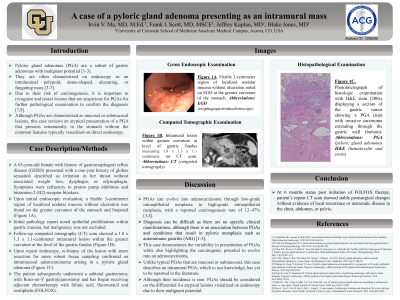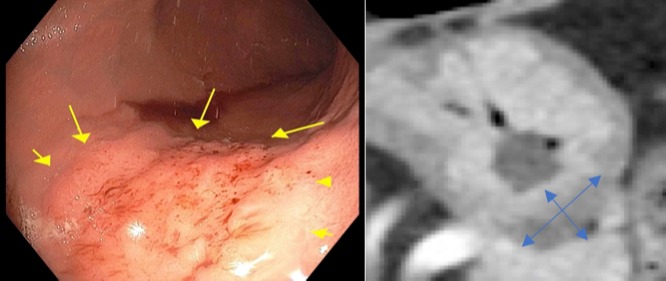Back


Poster Session D - Tuesday Morning
Category: Stomach
D0708 - A Case of a Pyloric Gland Adenoma Presenting as an Intramural Mass
Tuesday, October 25, 2022
10:00 AM – 12:00 PM ET
Location: Crown Ballroom

Has Audio

Irvin V. Ma, MD
University of Colorado Anschutz Medical Campus
Aurora, CO
Presenting Author(s)
Irvin V. Ma, MD1, Frank I. Scott, MD1, Jeffrey Kaplan, MD1, Blake Jones, MD2
1University of Colorado Anschutz Medical Campus, Aurora, CO; 2University of Colorado Anschutz Medical Campus, Arvada, CO
Introduction: Pyloric gland adenomas (PGA) are a subset of gastric adenomas with malignant potential. They are often characterized on endoscopy as an intraluminal polypoid, dome-shaped, ulcerating, or fungating mass. Due to their risk of carcinogenesis, it is important to recognize and resect lesions that are suspicious for PGAs for further pathological examination to confirm the diagnosis. Although PGAs are characterized as mucosal or submucosal lesions, this case reviews an atypical presentation of a PGA that presents intramurally in the stomach without the common features typically visualized on direct endoscopy.
Case Description/Methods: A 65-year-old female with history of GERD presented with a one-year history of globus sensation described as irritation in her throat without associated weight loss, dysphagia, or odynophagia. Symptoms were refractory to proton pump inhibitors and H2 blockers. Upon initial endoscopic evaluation, a friable 3-centimeter region of localized nodular mucosa without ulceration was found on the greater curvature of the stomach and biopsied (Figure 1A). Initial pathology report noted epithelial proliferation within gastric mucosa, but malignancy was not excluded. Follow-up CT scan showed a 1.8 x 1.3 x 1.1 centimeter intramural lesion within the greater curvature at the level of the gastric fundus (Figure 1B). Upon repeat endoscopy, re-biopsy of the lesion with snare resection for more robust tissue sampling confirmed an intramucosal adenocarcinoma arising in a pyloric gland adenoma. The patient subsequently underwent a subtotal gastrectomy with Roux-en-Y gastrojejunostomy and has begun receiving adjuvant chemotherapy with folinic acid, fluorouracil and oxaliplatin (FOLFOX).
Discussion: This case demonstrates the variability in presentation of PGAs while also highlighting the carcinogenic potential to evolve into an adenocarcinoma. Unlike typical PGAs that are mucosal or submucosal, this case describes an intramural PGA, which to our knowledge, has yet to be reported in the literature. Although their incidence is rare, PGAs should be considered on the differential for atypical lesions visualized on endoscopy due to their malignant potential.

Disclosures:
Irvin V. Ma, MD1, Frank I. Scott, MD1, Jeffrey Kaplan, MD1, Blake Jones, MD2. D0708 - A Case of a Pyloric Gland Adenoma Presenting as an Intramural Mass, ACG 2022 Annual Scientific Meeting Abstracts. Charlotte, NC: American College of Gastroenterology.
1University of Colorado Anschutz Medical Campus, Aurora, CO; 2University of Colorado Anschutz Medical Campus, Arvada, CO
Introduction: Pyloric gland adenomas (PGA) are a subset of gastric adenomas with malignant potential. They are often characterized on endoscopy as an intraluminal polypoid, dome-shaped, ulcerating, or fungating mass. Due to their risk of carcinogenesis, it is important to recognize and resect lesions that are suspicious for PGAs for further pathological examination to confirm the diagnosis. Although PGAs are characterized as mucosal or submucosal lesions, this case reviews an atypical presentation of a PGA that presents intramurally in the stomach without the common features typically visualized on direct endoscopy.
Case Description/Methods: A 65-year-old female with history of GERD presented with a one-year history of globus sensation described as irritation in her throat without associated weight loss, dysphagia, or odynophagia. Symptoms were refractory to proton pump inhibitors and H2 blockers. Upon initial endoscopic evaluation, a friable 3-centimeter region of localized nodular mucosa without ulceration was found on the greater curvature of the stomach and biopsied (Figure 1A). Initial pathology report noted epithelial proliferation within gastric mucosa, but malignancy was not excluded. Follow-up CT scan showed a 1.8 x 1.3 x 1.1 centimeter intramural lesion within the greater curvature at the level of the gastric fundus (Figure 1B). Upon repeat endoscopy, re-biopsy of the lesion with snare resection for more robust tissue sampling confirmed an intramucosal adenocarcinoma arising in a pyloric gland adenoma. The patient subsequently underwent a subtotal gastrectomy with Roux-en-Y gastrojejunostomy and has begun receiving adjuvant chemotherapy with folinic acid, fluorouracil and oxaliplatin (FOLFOX).
Discussion: This case demonstrates the variability in presentation of PGAs while also highlighting the carcinogenic potential to evolve into an adenocarcinoma. Unlike typical PGAs that are mucosal or submucosal, this case describes an intramural PGA, which to our knowledge, has yet to be reported in the literature. Although their incidence is rare, PGAs should be considered on the differential for atypical lesions visualized on endoscopy due to their malignant potential.

Figure: Figure 1: Friable nodular ulceration on greater curvature of stomach (A), Intramural lesion within greater curvature at level of gastric fundus on CT scan (B)
Disclosures:
Irvin Ma indicated no relevant financial relationships.
Frank Scott indicated no relevant financial relationships.
Jeffrey Kaplan indicated no relevant financial relationships.
Blake Jones indicated no relevant financial relationships.
Irvin V. Ma, MD1, Frank I. Scott, MD1, Jeffrey Kaplan, MD1, Blake Jones, MD2. D0708 - A Case of a Pyloric Gland Adenoma Presenting as an Intramural Mass, ACG 2022 Annual Scientific Meeting Abstracts. Charlotte, NC: American College of Gastroenterology.
